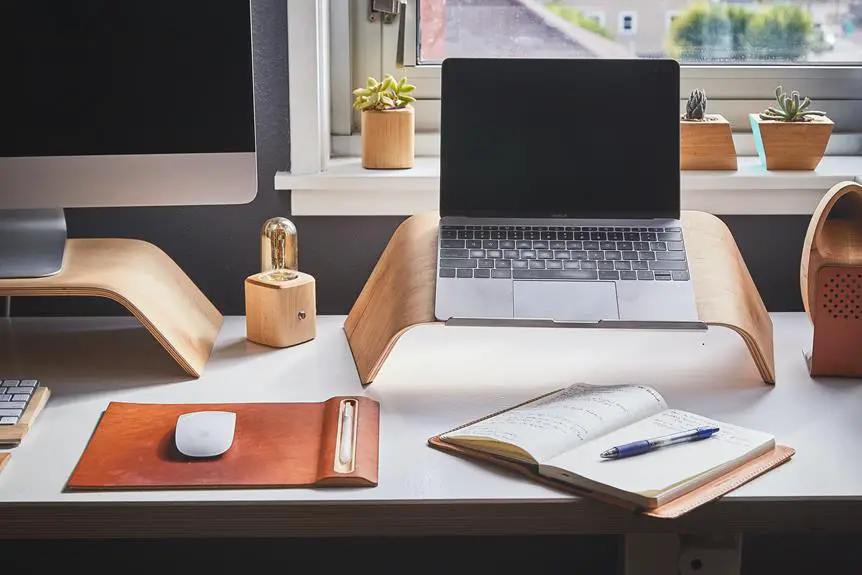Hey there, are you tired of feeling like Goldilocks trying to find the perfect chair and desk setup for your home office? It can be a real struggle to find furniture that fits just right when you're on the shorter side.
But fear not, because in this discussion, we'll explore some practical tips and solutions to help you create a comfortable and efficient workspace tailored specifically for short users.
So, if you're ready to say goodbye to constantly adjusting your chair or straining to reach your keyboard, stick around for some valuable insights and recommendations that'll make a world of difference in your home office setup.
Key Takeaways
- Adjust desk and chair to fit body proportions and movements
- Look for a chair with adjustable seating options, including seat height and lumbar support
- Utilize storage solutions that are easily accessible and within reach
- Ensure proper lighting and visibility in the home office environment
Ergonomic Desk and Chair Setup
For optimal comfort and posture, adjust your desk and chair to fit your body's proportions and movements. As a short user, finding the right ergonomic setup can make a world of difference.
Standing desk options are a great way to customize your workspace for maximum comfort. Look for desks that are adjustable in height so you can switch between sitting and standing throughout the day. This can help alleviate any discomfort or strain from sitting for long periods.
When it comes to your chair, customized workspace solutions are key. Look for a chair with adjustable seat height, armrests, and lumbar support. Ensure that your feet can rest flat on the floor and that your knees are at a 90-degree angle when seated. This will help prevent any strain on your lower back and legs.
Consider investing in a footrest if your feet don't comfortably reach the floor when seated. This small addition can make a big difference in your overall comfort.
Additionally, make sure your keyboard and mouse are at a height that allows your arms to rest comfortably at your sides and your wrists to remain straight while typing.
Optimizing Monitor and Keyboard Heights
To optimize your workstation, adjust the monitor and keyboard heights to ensure they're at a comfortable and ergonomic position for your use. When setting up your monitor, position it directly in front of you at eye level. This helps reduce strain on your neck and minimizes screen glare, which can cause eye fatigue. If you're using a laptop, consider using a laptop stand or a stack of books to raise the screen to the appropriate height. Additionally, adjust the monitor's brightness and contrast settings to reduce glare and enhance visibility.
Next, focus on your keyboard placement. Position the keyboard so that your elbows are at a 90-degree angle when typing. This helps prevent wrist strain and allows for better wrist support. If your keyboard is too high or too low, it can lead to discomfort and potential long-term issues. Consider using a keyboard tray or an adjustable keyboard stand to achieve the ideal height.
Selecting the Right Chair for Short Users
Consider selecting a chair that provides proper back support and allows your feet to rest flat on the floor. As a short user, finding the right chair is crucial for maintaining good posture and preventing discomfort. Look for adjustable seating options that allow you to customize the chair to your body's unique needs. Customized ergonomic support is essential for ensuring that the chair fits your body properly, providing comfort and reducing the risk of strain or injury.
When choosing a chair, pay attention to the following key features:
| Features | Benefits |
|---|---|
| Adjustable Seat Height | Ensures your feet can rest flat on the floor, promoting proper posture and reducing strain on your legs. |
| Lumbar Support | Provides crucial support to the lower back, helping maintain the natural curve of the spine and reducing the risk of back pain. |
| Armrest Height Adjustment | Allows you to position the armrests at the correct height, supporting your arms and reducing shoulder and neck tension. |
Selecting a chair with these features will help you create a comfortable and ergonomic workspace tailored to your body's specific requirements. By investing in a chair that offers adjustable and customized support, you can optimize your home office environment for improved productivity and overall well-being.
Efficient Storage Solutions for Limited Reach
After ensuring your chair provides the necessary support for your body, it's important to consider efficient storage solutions for items within limited reach in your home office setup. Limited reach can make it challenging to access items quickly, so here are some storage solutions tailored for short users like you:
- Adjustable Shelving: Invest in shelving units that allow you to customize the height of each shelf. This way, you can place frequently used items within easy reach and adjust the shelves to accommodate your height.
- Pull-Out Drawers: Consider desks or cabinets with pull-out drawers. These allow you to maximize storage space while ensuring that everything is easily accessible without having to overreach.
- Compact Filing: Opt for compact filing cabinets or organizers that aren't too tall, making it effortless to reach important documents and supplies without straining.
- Utilize Wall Space: Install wall-mounted storage units or floating shelves. These can be placed at the perfect height for your reach, keeping essential items within arm's length without taking up valuable floor space.
Ensuring Proper Lighting and Visibility
Looking for lighting that suits your needs in your home office setup can greatly enhance your productivity and comfort. As a short user, ensuring proper lighting and visibility is essential for your well-being and efficiency. Adjustable lighting is a game-changer for creating a personalized workspace.
Task lamps with adjustable arms and heads allow you to direct light exactly where you need it, preventing eye strain and enhancing visibility of your work area.
Natural light can also play a significant role in your home office. When considering window placement, think about how the natural light will interact with your workspace throughout the day. Placing your desk near a window can provide ample natural light, which not only brightens up your space but also reduces the need for artificial lighting during the day. However, it's important to consider potential glare and the impact of changing natural light conditions on your computer screen.
Incorporating a combination of adjustable lighting and natural light can create an ideal working environment for short users. Experiment with different lighting setups to find the perfect balance that suits your specific needs.
Frequently Asked Questions
What Are Some Tips for Organizing and Decluttering a Small Home Office Space?
To organize and declutter a small home office, focus on maximizing storage and utilizing vertical space. Use wall shelves, stackable bins, and a compact desk. Keep only essentials and use drawer organizers for easy access.
Are There Any Specific Brands or Models of Ergonomic Furniture That Are Designed Specifically for Short Users?
Sure, there are ergonomic chairs and standing desks designed for short users, like the X-Chair X2 and the Uplift V2 standing desk. Plus, custom desks and adjustable monitor risers can help create a perfect fit for your home office.
How Can Short Users Adjust Their Computer Mouse and Accessories for Optimal Comfort and Productivity?
Adjust your computer mouse and accessories to fit your height for optimal comfort and productivity. Look for adjustable furniture and an ergonomic setup that allows you to customize your workstation to your specific needs.
What Are Some Creative Solutions for Managing Cables and Cords in a Small Home Office?
Tired of the cable chaos? Wrangle those unruly cords with clever solutions like cable clips, zip ties, and cable sleeves. Keep your workspace tidy and ergonomic for maximum comfort and focus.
Are There Any Recommended Lighting Options for Reducing Glare and Eye Strain in a Home Office for Short Users?
To reduce glare and eye strain in your home office, consider using adjustable task lighting and desk lamps. Position them to minimize reflections and shadows. Look for ergonomic furniture that allows you to work comfortably and maintain good posture.




